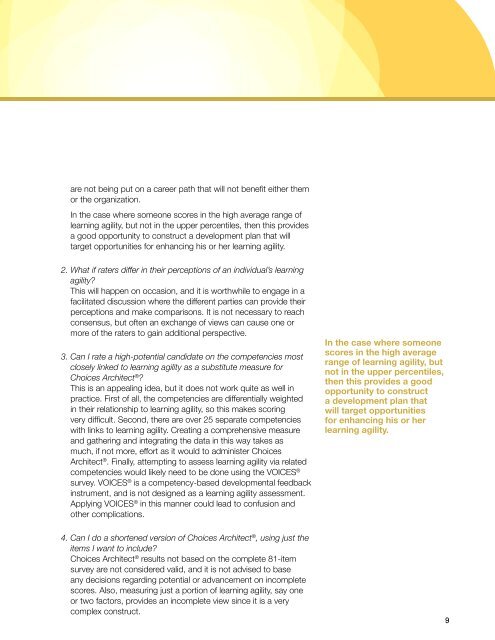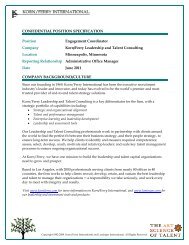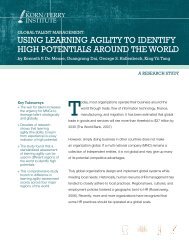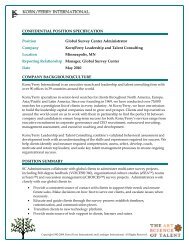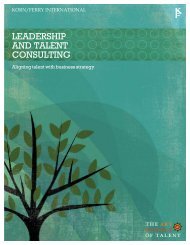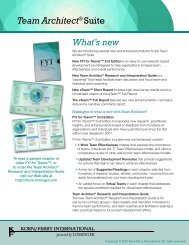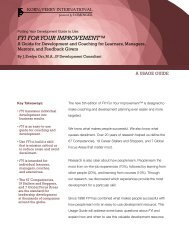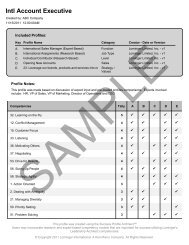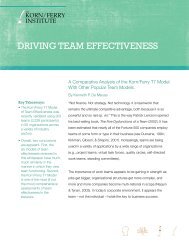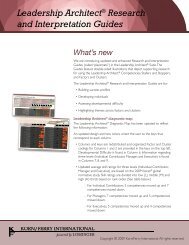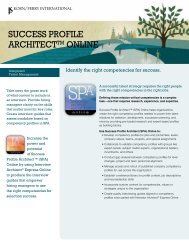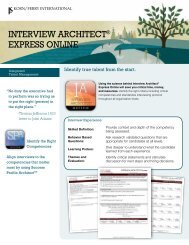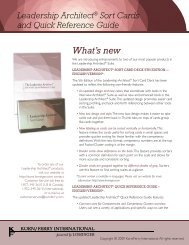understanding and applying tools to identiFy and ... - Lominger
understanding and applying tools to identiFy and ... - Lominger
understanding and applying tools to identiFy and ... - Lominger
Create successful ePaper yourself
Turn your PDF publications into a flip-book with our unique Google optimized e-Paper software.
are not being put on a career path that will not benefit either themor the organization.In the case where someone scores in the high average range oflearning agility, but not in the upper percentiles, then this providesa good opportunity <strong>to</strong> construct a development plan that willtarget opportunities for enhancing his or her learning agility.2. What if raters differ in their perceptions of an individual’s learningagility?This will happen on occasion, <strong>and</strong> it is worthwhile <strong>to</strong> engage in afacilitated discussion where the different parties can provide theirperceptions <strong>and</strong> make comparisons. It is not necessary <strong>to</strong> reachconsensus, but often an exchange of views can cause one ormore of the raters <strong>to</strong> gain additional perspective.3. Can I rate a high-potential c<strong>and</strong>idate on the competencies mostclosely linked <strong>to</strong> learning agility as a substitute measure forChoices Architect ® ?This is an appealing idea, but it does not work quite as well inpractice. First of all, the competencies are differentially weightedin their relationship <strong>to</strong> learning agility, so this makes scoringvery difficult. Second, there are over 25 separate competencieswith links <strong>to</strong> learning agility. Creating a comprehensive measure<strong>and</strong> gathering <strong>and</strong> integrating the data in this way takes asmuch, if not more, effort as it would <strong>to</strong> administer ChoicesArchitect ® . Finally, attempting <strong>to</strong> assess learning agility via relatedcompetencies would likely need <strong>to</strong> be done using the VOICES ®survey. VOICES ® is a competency-based developmental feedbackinstrument, <strong>and</strong> is not designed as a learning agility assessment.Applying VOICES ® in this manner could lead <strong>to</strong> confusion <strong>and</strong>other complications.In the case where someonescores in the high averagerange of learning agility, butnot in the upper percentiles,then this provides a goodopportunity <strong>to</strong> constructa development plan thatwill target opportunitiesfor enhancing his or herlearning agility.4. Can I do a shortened version of Choices Architect ® , using just theitems I want <strong>to</strong> include?Choices Architect ® results not based on the complete 81-itemsurvey are not considered valid, <strong>and</strong> it is not advised <strong>to</strong> baseany decisions regarding potential or advancement on incompletescores. Also, measuring just a portion of learning agility, say oneor two fac<strong>to</strong>rs, provides an incomplete view since it is a verycomplex construct.9


